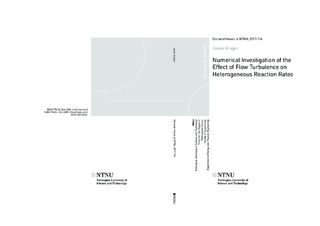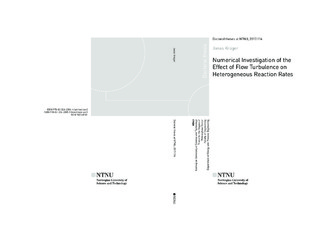| dc.contributor.advisor | Løvås, Terese | |
| dc.contributor.advisor | Haugen, Nils E. | |
| dc.contributor.author | Krüger, Jonas | |
| dc.date.accessioned | 2017-05-16T07:31:36Z | |
| dc.date.available | 2017-05-16T07:31:36Z | |
| dc.date.issued | 2017 | |
| dc.identifier.isbn | 978-82-326-2305-1 | |
| dc.identifier.issn | 1503-8181 | |
| dc.identifier.uri | http://hdl.handle.net/11250/2442567 | |
| dc.description.abstract | In this thesis, the effect of turbulence on heterogeneous reactions is investigated. After a short introduction into the state-of-the-art of turbulent combustion modelling, an overview over the numerical methods and models used to simulate homogeneous and heterogeneous combustion in turbulent flows is given. Then, a brief introduction into the most important features of the numerical implementation is provided.
Simulations featuring a simple heterogeneous reaction system involving a passive reactant are performed with a compressible Direct Numerical Simulation (DNS) Computational Fluid Dynamics (CFD) code, called ”The Pencil Code”. Different particle numbers, sizes and flow properties are investigated, and an inhibiting effect of the turbulence on the reaction rates for high particle numbers is found.
In further studies using the simplified model, the inhibiting effect is quantified for a range of particle numbers, and a model predicting the inhibiting effect from flow and particle properties is proposed.
A sub model for the detailed modelling of particles burning in a cloud of gas, the ”Stanford Code” is extended and implemented into ”The Pencil Code”. The proposed model to predict the inhibiting effect is compared against data from simulations that use real chemistry represented by a simple reaction mechanism. Agreement between the proposed model obtained from the simplified reaction systems and the data from the more complex combustion system is found to be good.
The performance of the proposed model is discussed and recommendations for further work to increase the predictive capabilities of the model are given. | nb_NO |
| dc.language.iso | eng | nb_NO |
| dc.publisher | NTNU | nb_NO |
| dc.relation.ispartofseries | Doctoral theses at NTNU;2017:116 | |
| dc.relation.haspart | Paper 1: Krüger, Jonas; Haugen, Nils Erland L; Løvås, Terese; mitra, dhrubaditya. A study on the coupling between isotropic turbulence and heterogeneous reactions. I: Proceedings of MekIT'15 Eighth National Conference on Computational Mechanics. International Center for Numerical Methods in Engineering (CIMNE) 2015 ISBN 97884944244-96. s. 243-257 | nb_NO |
| dc.relation.haspart | Paper 2: Krüger, Jonas; Haugen, Nils Erland L; Mitra, Dhrubaditya; Løvås, Terese. The effect of turbulent clustering on particle reactivity. Proceedings of the Combustion Institute 2016 ;Volum 36.(2) s. 2333-2340
https://doi.org/10.1016/j.proci.2016.06.187 | nb_NO |
| dc.relation.haspart | Paper 3: Lazar, Joanna; Haugen, Nils Erland L; Krüger, Jonas; Szlek, Andrzej. Numerical Study of Hydrogen Inhibition of Char Gasification Using Detailed Hetero- and Homogeneous Chemical Kinetics. Energy & Fuels 2016 ;Volum 30.(6) s. 4411-4418
http://dx.doi.org/10.1021/acs.energyfuels.6b00502
Copyright © 2016 American Chemical Society | nb_NO |
| dc.relation.haspart | Paper 4: Nils E.L. Haugen, Jonas Kr¨uger, Dhrubaditya Mitra and Terese Løvås (2017). The effect of turbulence on mass and heat transfer rates of small inertial particles | nb_NO |
| dc.relation.haspart | Paper 5: Jonas Kr¨uger, Nils E.L. Haugen and Terese Løvås (2017). Correlation effects between turbulence and the conversion rate of pulverized char particles. -
© 2017. This manuscript version is made available under the CC-BY-NC-ND 4.0 license - Published in
Combustion and Flame 2017 ;Volum 185. s. 160-172 https://doi.org/10.1016/j.combustflame.2017.07.008 | nb_NO |
| dc.title | Numerical Investigation of the Effect of Flow Turbulence on Heterogeneous Reaction Rates | nb_NO |
| dc.type | Doctoral thesis | nb_NO |
| dc.subject.nsi | VDP::Technology: 500::Environmental engineering: 610 | nb_NO |

